Physical Address
304 North Cardinal St.
Dorchester Center, MA 02124
For the answer, see the figure legend.
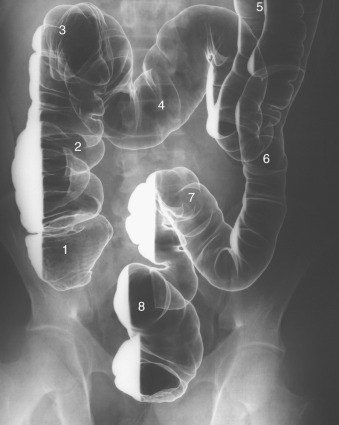
The longitudinal muscle layer of the colon is divided into three thick bands, termed the taeniae coli . There is a paucity of longitudinal muscle between the three tenial bands. Haustra are sacculations of colon protruding between the three rows of taeniae coli ( Figures 26-2 and 26-3 ). At the edges of the haustral sacculations, folds, termed interhaustral folds , radiate toward the taeniae coli. The colon is identified by its haustral sacculations and interhaustral folds on any radiologic study—whether plain abdominal radiograph, computed tomography (CT), magnetic resonance imaging (MRI), or barium enema. Rounded, air-filled pockets are seen in a nondependent (anterior) position. Fluid-filled or contrast-filled rounded sacculations are seen on the dependent (inferior) surface.
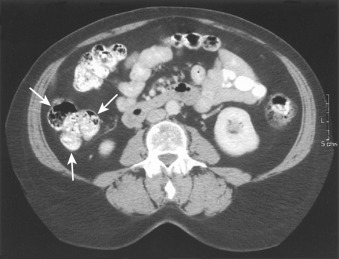
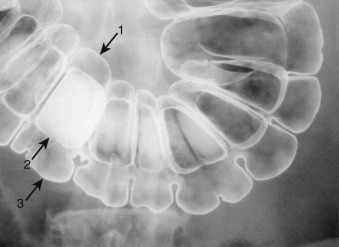
Haustra are relatively fixed structures in the right and transverse colon. Haustra are intermittently seen structures in the descending and proximal sigmoid colon, depending on the stage of colonic contraction. The left colon may intermittently appear “ahaustral,” depending on the degree of colonic contraction. Although the edge of the colon has a sacculated appearance, the edge of the small bowel is relatively straight, altered only by its thin valvulae conniventes. Valvulae conniventes are thinner than interhaustral folds and cross the entire lumen of the bowel, whereas interhaustral folds cross about one third of the colonic diameter when seen in profile. Seen en face, the interhaustral folds may falsely appear to cross the entire lumen of the colon.
A double-contrast (or air-contrast) barium enema examination uses two contrast agents to image the colon. A medium-density, medium-viscosity barium suspension is instilled into the colon via a rectal tube. This barium scrubs residual feces and fluid into the suspension and then coats the mucosal surface with barium. Air (or carbon dioxide) is insufflated via the rectal tube to distend the colon and render it “translucent.” The end result is that the mucosal surface is “etched” in white by barium, and the colonic walls are widely separated. Spot radiographs and overhead images are then obtained. A colonic hypotonic agent (1 mg of intravenous glucagon) is routinely administered at our hospital. Other hospitals use glucagon only if there is colonic spasm, excessive patient discomfort, or inability to retain the contrast agent. In other countries, an anticholinergic agent (e.g., hyoscine butylbromide [Buscopan]) may be used to induce colonic hypotonia.
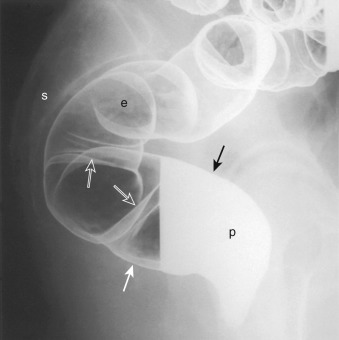
Air-barium levels are the clue to the patient's position. Barium is heavier than air; barium identifies the “down” side of the patient. The air-barium levels show that the patient is lying with his or her right side down. The x-ray tube is positioned in a cross-table position , with the x-ray tube at one side of the tabletop, so the x-ray beam parallels the tabletop. A cassette is placed in an upright position, perpendicular to the tabletop, in front or in back of the patient. This image is termed a right-side-down decubitus view .
A patient has to be able to hold the barium and air in his or her colon; anal sphincter tone must be normal. The patient must be able to roll upon the tabletop of the fluoroscope; he or she must be strong enough to roll over in bed. The radiologist must be able to communicate with the patient. If the patient does not speak the same language as the radiologist, a translator must be provided. The patient must have enough mental acuity to be able to understand and respond to the following commands: “Don't breathe/breathe,” “Turn left/turn right,” and “Hold the barium in your rectum.”
This is a spot radiograph from a single-contrast barium enema examination. This type of examination uses one contrast agent: low-density barium. Under fluoroscopic control, the colon is filled with barium. Spot radiographs and overhead images of the entire colon are obtained. Postevacuation spot radiographs or overhead images are also obtained.
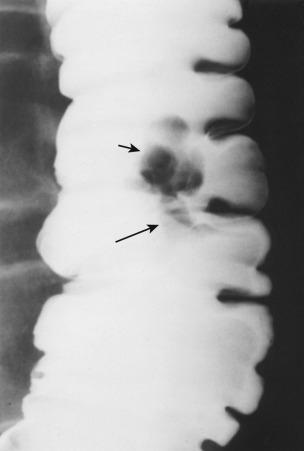
Indications for double-contrast barium enema examination include rectal bleeding, diarrhea, abdominal pain, screening for colorectal neoplasia, or involvement of the colon by extracolonic inflammatory or neoplastic masses.
A single-contrast barium enema examination may be performed in patients with suspected fistula, high-grade colonic obstruction, or Hirschsprung's disease. If a distal small bowel obstruction is suspected, a single-contrast barium enema examination with reflux of barium into the distal ileum to the point of obstruction may be performed as a complementary study to CT.
Each hospital has its own preparation for a barium enema that should be available from the department of radiology. Preparations generally include (1) a period during which solid food is limited in an effort to reduce undigested material reaching the colon, (2) an oral laxative, and (3) a medication that induces colonic contraction. The preparation at the Hospital of the University of Pennsylvania includes the following:
Clear liquids only are allowed the day before the examination.
At 5 PM the day before the examination, 10 to 16 oz of magnesium citrate is given.
The patient should drink at least three to four 8 oz glasses of water throughout the day of the examination to maintain hydration.
At 10 PM the evening before the examination, four 5 mg bisacodyl tablets are taken with 8 oz of water.
The patient should have nothing by mouth after midnight the night before until after the examination.
The patient is given a bisacodyl suppository the morning of the examination.
Insulin dose is reduced or eliminated the morning of the examination.
After the examination, patients are encouraged to drink water and take laxatives if they have colonic hypomotility.
At our hospital, we do not use large-volume colonic lavage agents that are used for colonoscopy because they leave large amounts of fluid in the colon that degrade barium coating of the mucosa. Cleansing enemas are discouraged because they push fecal residue into the right colon and leave residual fluid in the colon.
A 2-day preparation may be necessary in immobile or bedridden patients, patients with hypomotility disorders such as diabetes mellitus or hypothyroidism, postoperative patients, or patients taking opiates or drugs with anticholinergic side effects.
Known or suspected colonic perforation. If a perforation is suspected, CT or an enema using a water-soluble contrast agent should be used.
Fulminant colitis (“toxic megacolon”) or any severe colitis.
A recent procedure that has potentially created a hole in the colonic mucosa. A barium enema should be postponed for 1 week if a large forceps biopsy at rigid sigmoidoscopy, a snare polypectomy, or a hot biopsy has been performed. A biopsy specimen taken with small forceps via a flexible endoscope is not a contraindication.
Also, the clinician should alert the radiologist if a patient has a latex allergy, so all products containing latex can be removed from the fluoroscopic suite, and the room can be cleaned before a procedure.
Patients with known or suspected insulinoma or pheochromocytoma should not receive intravenous glucagon.
Patients with latex allergy should be scheduled first in the day, after the room has been cleaned. Insulin-dependent diabetic patients, patients with hypoglycemia, and other patients who require breakfast should be scheduled as early in the day as possible.
Become a Clinical Tree membership for Full access and enjoy Unlimited articles
If you are a member. Log in here